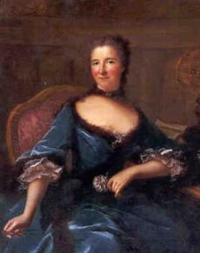Gabrielle-Émilie Le Tonnelier de Breteuil, marquise du Châtelet
Mathematician, physicist and philosopher, b. 17 December 1706 (Paris, France), d. 10 September 1749 (Lunéville).
 Madame du Châtelet was from a family of the upper classes. Her father, Louis-Nicolas Baron de Breteuil, owned land and a grand property in Paris. The young Gabrielle-Émilie received a good education; at the age of twelve she was tutored in Latin, Italian and English. Her training did not only cover literature and music but, somewhat unusual for a young girl of her time, science as well.
Madame du Châtelet was from a family of the upper classes. Her father, Louis-Nicolas Baron de Breteuil, owned land and a grand property in Paris. The young Gabrielle-Émilie received a good education; at the age of twelve she was tutored in Latin, Italian and English. Her training did not only cover literature and music but, somewhat unusual for a young girl of her time, science as well.
At the age of 19 she was married to the governor of Semur-en-Auxois, Marquis Florent Claude Chastellet (later changed to Châtelet). The marriage produced three children in 1726, 1727 and 1733.
Her husband soon left for a military career and was rarely at home. In 1730 Madame du Châtelet therefore returned to Paris, where she entered an active social life, visited the theatre and opera, tried gambling and had several lovers before she met Voltaire in 1733, with whom she lived for the next 15 years.
The close intellectual bonds with Voltaire allowed du Châtelet to develop her own gifts fully. When Voltaire had to flee arrest in Paris the two moved to her château at Cirey in Champagne and began a most productive liaison. Madame du Châtelet had a physical laboratory constructed in her property and concentrated on bringing the new ideas of modern science to France. She became fluent in English and began in 1745 with the translation of Newton's Principia Mathematica. She also popularized the ideas of Leibnitz through her work Institutions de physique of 1740.
In 1738 Voltaire and du Châtelet sent independent submissions to a competition organized by the Academy of Sciences. The prize was won by the German mathematician Leonard Euler, but the Academy agreed to print Madame du Châtelet's submission Dissertation sur la nature et la propagation du feu (Dissertation on the nature and propagation of fire) at the Academy's expense, and the work was published in 1744. Many other works on science, philosophy and religion carry her name.
After many years with Voltaire Madame du Châtelet began an affair with a poet and fell pregnant at the age of 42. Her husband agreed to pretend that the child was his, and Voltaire, her husband and her new lover were all at her side when she gave birth to a daughter. She died six days later and her child soon after.
Her translation of the Principia Mathematica, on which she was still working shortly before her death, was published in parts in 1756 with a preface by Voltaire. The complete translation, still the official and only French translation of Newton's work, appeared in 1759.
home
 Madame du Châtelet was from a family of the upper classes. Her father, Louis-Nicolas Baron de Breteuil, owned land and a grand property in Paris. The young Gabrielle-Émilie received a good education; at the age of twelve she was tutored in Latin, Italian and English. Her training did not only cover literature and music but, somewhat unusual for a young girl of her time, science as well.
Madame du Châtelet was from a family of the upper classes. Her father, Louis-Nicolas Baron de Breteuil, owned land and a grand property in Paris. The young Gabrielle-Émilie received a good education; at the age of twelve she was tutored in Latin, Italian and English. Her training did not only cover literature and music but, somewhat unusual for a young girl of her time, science as well.